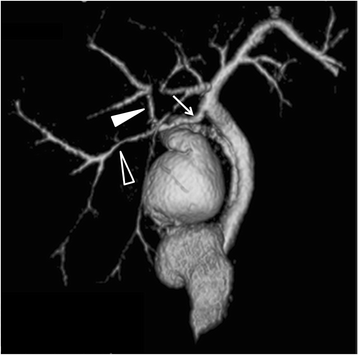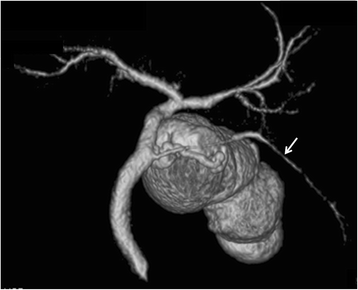Preoperative evaluation of accessory hepatic ducts by drip infusion cholangiography with CT
- PMID: 28482819
- PMCID: PMC5422935
- DOI: 10.1186/s12893-017-0251-9
Preoperative evaluation of accessory hepatic ducts by drip infusion cholangiography with CT
Abstract
Background: This retrospective study aimed to investigate the incidence of each type of accessory hepatic duct by drip infusion cholangiography with CT (DIC-CT).
Methods: Five hundred sixty nine patients who underwent preoperative DIC-CT and laparoscopic cholecystectomy were reviewed. Accessory hepatic ducts were classified as follows: type I (accessory hepatic ducts that merged with the common hepatic duct between the confluence of the right and left hepatic ducts and the cystic duct confluence), type II (those that merged with the common hepatic duct at the same site as the cystic duct), type III (those that merged with the common bile duct distal to the cystic duct confluence), type IV (the cystic duct merged with the accessory hepatic duct), and type V (accessory hepatic ducts that merged with the common hepatic or bile duct on the left side).
Results: Accessory hepatic ducts were observed in 50 patients. Type I, II, III, IV, and V accessory hepatic ducts were detected in 32, 3, 1, 11, and 3 patients, respectively. Based on their drainage areas, the accessory hepatic ducts were also classified as follows: a posterior branch in 22 patients, an anterior branch in 9 patients, a combination of posterior and anterior branches in 16 patients, a left-sided branch in 2 patients, and a caudate branch in 1 patient. None of the patients with accessory hepatic ducts suffered bile duct injuries.
Conclusion: There are a number of variants of the accessory hepatic duct. DIC-CT is useful to detect the accessory hepatic duct.
Keywords: Accessory hepatic duct; Bile duct injury; Drip infusion cholangiography with CT; Laparoscopic cholecystectomy.
Figures







Similar articles
-
Preoperative evaluation of the extrahepatic bile duct structure for laparoscopic cholecystectomy.Surg Endosc. 2006 Jul;20(7):1119-23. doi: 10.1007/s00464-005-0689-1. Epub 2006 May 13. Surg Endosc. 2006. PMID: 16703426
-
Distributing pattern of the bile duct of the caudate lobe on computed tomography with drip infusion cholangiography and its surgical significance.Hepatogastroenterology. 2004 Jan-Feb;51(55):29-32. Hepatogastroenterology. 2004. PMID: 15011825
-
Noninvasive imaging of the biliary tree before or after laparoscopic cholecystectomy: use of three-dimensional spiral CT cholangiography.AJR Am J Roentgenol. 1994 Jun;162(6):1331-5. doi: 10.2214/ajr.162.6.8191994. AJR Am J Roentgenol. 1994. PMID: 8191994
-
Bile duct confluence: anatomic variations and its classification.Surg Radiol Anat. 2014 Mar;36(2):105-9. doi: 10.1007/s00276-013-1157-6. Epub 2013 Jul 2. Surg Radiol Anat. 2014. PMID: 23817807 Review.
-
Anomalous insertion of the right hepatic duct into the cystic duct: report of a case diagnosed before laparoscopic cholecystectomy.Surg Laparosc Endosc Percutan Tech. 1999 Jun;9(3):211-2. Surg Laparosc Endosc Percutan Tech. 1999. PMID: 10804003 Review.
Cited by
-
Modified and dynamic intraoperativecholangiography during laparoscopic cholecystectomy in two patients with aberrant right posterior hepatic duct.Radiol Case Rep. 2022 Apr 4;17(6):1843-1847. doi: 10.1016/j.radcr.2022.03.031. eCollection 2022 Jun. Radiol Case Rep. 2022. PMID: 35401891 Free PMC article.
-
Gallbladder cancer concomitant with autosomal dominant polycystic kidney disease: A case report.Clin Case Rep. 2022 Dec 15;10(12):e6734. doi: 10.1002/ccr3.6734. eCollection 2022 Dec. Clin Case Rep. 2022. PMID: 36540879 Free PMC article.
-
Novel per-oral cholangioscopy for treatment of occult accessory hepatic duct stones.Gastroenterol Rep (Oxf). 2023 Aug 30;11:goad051. doi: 10.1093/gastro/goad051. eCollection 2023. Gastroenterol Rep (Oxf). 2023. PMID: 37661998 Free PMC article. No abstract available.
-
Topographical relationship between the accessory hepatic duct and the hepatic artery system.Anat Sci Int. 2021 Jan;96(1):112-118. doi: 10.1007/s12565-020-00568-6. Epub 2020 Sep 11. Anat Sci Int. 2021. PMID: 32914370
-
A case of a right accessory hepatic duct diagnosed during a Whipple procedure.Int J Surg Case Rep. 2018;51:210-212. doi: 10.1016/j.ijscr.2018.08.034. Epub 2018 Aug 23. Int J Surg Case Rep. 2018. PMID: 30193206 Free PMC article.
References
-
- Ochiai T, Yamazaki S, Ohta K, Takahashi M, Iwai T, Irie T, et al. Is drip infusion cholecystocholangiography (DIC) an acceptable modality at cholecystectomy for cholecystolithiasis, considering the frequency of bile duct maljunction and intraoperative bile duct injury? J Hepato-Biliary-Pancreat Surg. 2004;11:135–139. doi: 10.1007/s00534-003-0873-4. - DOI - PubMed
MeSH terms
LinkOut - more resources
Full Text Sources
Other Literature Sources
Medical

